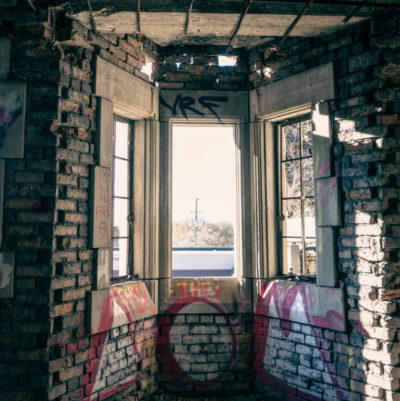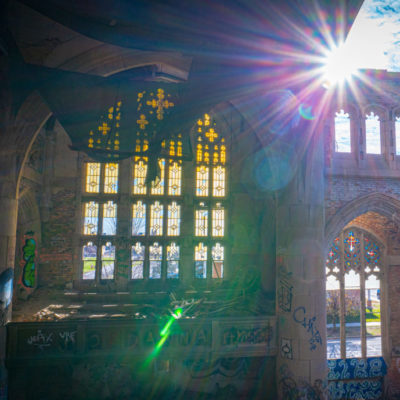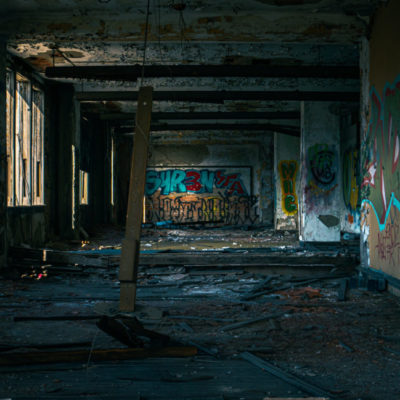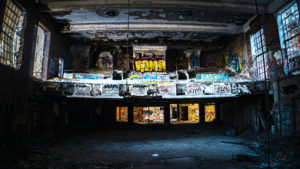
Wikipedia
If you are interested in learning more about the history of this property, Check out the Wikipedia Link below

Indiana History Blog
A blog about the property, Helpful for more research
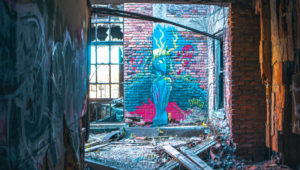
Youtube
Experience the explore with us first hand.

Gary, IN
City Methodist Church
Explore.
We arrived on a sunny day. It was bright, cars drove as we approached the property. We could hear people arguing at the bus stop as we walked in. Graffiti lined the walls as we entered. Other explorers names written on the wall. Piles of clothes on the stage of the auditorium, and in the back offices and..well, everywhere really. It was strange, there didnt seem to be any signs of anyone living in there despite it being the perfect respite from the wind and elements. As we made our way to the roof, the damages to the property were made even more clear, as the roof of the structure was almost non-existent.
History.
After Gary declined in the 1960s and 70s, the church’s fortunes began to likewise crumble. Predominantly a white middle-class institution, the church lost large numbers of parishioners to white flight as Gary’s social makeup altered and better-off inhabitants moved away. Crime rates in the area soared, causing more departures, and maintenance costs were ruinous, owing to the church’s huge dimensions and the harsh lakefront climate. By 1973, there were only 320 members in the then-aging congregation, about a third of whom regularly attended. After attempts to sell the building to another congregation proved fruitless, the decision was eventually taken to close the church in 1975.A Methodist church had been present in Gary since 1906 (also the year of the city’s founding). In 1916, Dr William Grant Seaman became its pastor. A man of dynamic energy, Seaman envisaged a much larger church to serve the town, wanting to bring a prominent religious presence into what was then a somewhat insalubrious neighbourhood with numerous brothels and drinking establishments. Seaman secured the backing of US Steel, the chief employer in the city. The company donated the site on which the church was to be built, and agreed to donate almost half of the cost. The construction, beginning in 1925 took 21 months and cost $800,000, a truly vast sum. The first service was held in the church on 3 October 1926. The organ was donated by Elbert Gary, after whom the city was named. The church was built Lowe and Bollenbacher of Chicago. The sanctuary at the forefront of the structure is part of a much larger nine-story complex which included an adjoining theatre called Seaman Hall, which could seat 1000 people, and contained corporate offices, a gymnasium, a Sunday School and a dining hall. There were plans for a bowling alley, but this was never built. A rooftop garden on the roof of the hall was never finished. By 1927, the church had a congregation of 1,700 and a staff of six.[1]
By 1929, William Seaman had grown unpopular with his parishioners, due at least in part to his interests in cultural diversity (including interfaith pageants). His dissatisfied congregation had him involuntarily transferred to Ohio. In some irony, his successor proved even less popular with the churchgoers. Seaman died in 1944. In accordance with his wishes, his ashes were returned to Gary, where they were interred in the church.[2]
During the Great Depression, the church leased part of Seaman Hall to Gary College to gain much-needed additional funds. In the postwar years, the Indiana University Centre used part of Seaman Hall, and 1949, Indiana University Northwest occupied three of the floors. The church reached the pinnacle of its popularity in the 1950s, with membership surpassing 3000.
- Built in 1925
- Closed in 1975
- Location: Gary, IN
- Date Explored: November 22nd 2021


